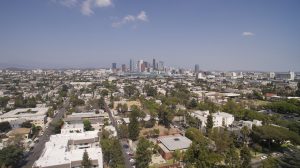
Home Affordability in the USC Area
In 2006, when USC began planning its new mixed-use “Village” development, the UNIDAD Coalition ––a group of community-based organizations in South Central–– arose to ensure
Variable Definitions:
Complaints: The total number of complaints about Los Angeles Housing Code violations filed by tenants to the Los Angeles Housing Department (LAHD)
Violations: The total number of violations of the Los Angeles Housing Code, discovered through inspections made after a complaint was submitted by a tenant or through inspections made during the Systematic Code Enforcement Program (SCEP)
Source: Los Angeles Housing Department (LAHD)
Years Available: 2005-2023
Methodology Note:
The original data comes at the point level. Our team geocoded the locations to generate X/Y coordinates, then spatial joined each point to 2020 Census Tracts.
Properties of two or more residential units with at least one of the units rented out are subject to the Los Angeles Housing Code, meaning the Los Angeles Housing Department (LAHD) must conduct regular inspections of the residential rental units through the Systematic Code Enforcement Program (SCEP). Tenants are able to report a housing code violation to LAHD if their landlord does not resolve a code issue in a timely manner after informing them of repairs needed. SCEP inspectors investigate the claims to determine the nature of the violation. If the inspector observes that a violation has occurred, the property owner has 30 days to correct it. If the violation is not corrected upon reinspection, the property may be placed in the Rent Escrow Account Program, which protects tenants living in substandard living situations, or the property owner may be referred to the Office of the City Attorney. Housing code violations include, but are not limited to: unsanitary building conditions, broken windows, defective smoke detectors, lack of ventilation, unsafe electrical wiring, and deteriorated plumbing.
Renters in the most precarious positions, such as low-income residents, formerly incarcerated citizens, and tenants who previously experienced eviction, are the most likely to have to move into a building with poor-quality conditions that are vulnerable to violations. Without landlord regulations or rent control, Black and Latino tenants are more likely to receive the repercussions of filing code violations, such as eviction or landlords increasing rent. Although rental units in the City are routinely inspected by LAHD, responsibility for housing code enforcement in unincorporated areas of L.A. County is split between five different departments; this allows for landlords to more easily avoid having to repair code violations.
Written by Gabby Magaña
Citations:
Bartram, R. (2018). The Cost of Code Violations: How Building codes Shape Residential Sales Prices and Rents. Housing Policy Debate, 29(6), 931-946. https://doi-org.libproxy2.usc.edu/10.1080/10511482.2019.1627567
Esquivel, P. (2023, April 10). L.A. County’s eviction moratorium has expired. What does that mean for renters? Los Angeles Times. https://www.latimes.com/california/story/2023-04-10/la-countys-eviction-moratorium-over-whats-next-for-tenants.
Los Angeles Housing Department. “Report Dashboard for Code Inspections.” https://housing.lacity.org/code
Los Angeles Housing + Community Investment Department. “The Systematic Code Enforcement Program (SCEP)”. (2020). https://housing.lacity.org/wp-content/uploads/2020/05/scep_english.pdf
The Praxis Project. “Housing.” (n.d.). https://www.thepraxisproject.org/sdoh/housing-justice
Wagner, D. (2022, April 5). “To Fight Slumlords, LA County Launches Plan to Strengthen Housing Inspections.” LAist. https://laist.com/news/housing-homelessness/to-fight-slumlords-la-county-launches-plan-to-strengthen-housing-inspections

In 2006, when USC began planning its new mixed-use “Village” development, the UNIDAD Coalition ––a group of community-based organizations in South Central–– arose to ensure

According to the Economic Policy Institute (EPI), 8.4 million jobs have been lost since the start of the pandemic in February 2020, and over 5 million people

Across the nation, the population experiencing homelessness is getting older. The end of the Baby Boomer generation (those born between 1955 and 1964) have faced
